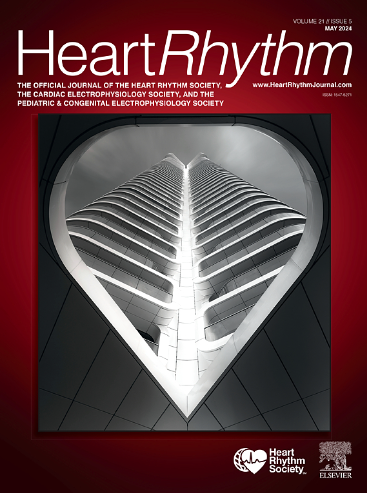针对肺静脉隔离前检测到的右肺静脉窦心外膜连接的导管消融方法。
IF 5.6
2区 医学
Q1 CARDIAC & CARDIOVASCULAR SYSTEMS
引用次数: 0
摘要
背景:从周围结构到右肺静脉(PV)窦的心外膜连接阻碍了PV隔离:本研究旨在评估针对心外膜连接的消融方法对右侧 PV 分离的疗效:我们前瞻性地招募了124名接受初始PV隔离的心房颤动患者。我们在 PV 隔离前右心房高起搏时绘制的激活图上确定了进入右 PV 腔的激活突破点(BT-RPV)。当通过宽前叶环形消融术(WACA)无法实现右侧 PV 隔离时,我们就以 BT-RPV 位点为目标:结果:83 个病例(67%)观察到 BT-RPV。所有 41 例无 BT-RPV 的病例均通过 WACA 实现了 PV 隔离。在有 BT-RPV 的病例中,当所有 BT-RPV 位点都被 PV 隔离线覆盖时,有 48 例病例通过 WACA 实现了 PV 隔离。相反,在 35 个未覆盖所有 BT-RPV 位点的病例中,只有 5 个病例通过 WACA 完成了 PV 隔离。在 WACA 失败的病例中,有 35 个部位被列为 BT-RPV 消融的目标。最初的 BT-RPV 消融导致 20 个部位的 PV 隔离,而其余 15 个 BT-RPV 位点需要重复 BT-RPV 消融。成功的 BT-RPV 消融面积为 0.9 [0.6-1.2] 平方厘米,相当于 BT-RPV 出现后 15 [14-16] 毫秒内激活的区域。消融 BT-RPV 出现后 14 毫秒内激活的区域与成功隔离 PV 相关(敏感性 91%,特异性 100%):结论:以 BT-RPV 位点为目标的消融对右侧 PV 隔离有效。结论:针对 BT-RPV 位点的消融对右侧 PV 隔离有效。本文章由计算机程序翻译,如有差异,请以英文原文为准。

Catheter ablation approach targeting epicardial connections to the right pulmonary vein antrum detected before pulmonary vein isolation
Background
Epicardial connections from surrounding structures to the right pulmonary vein (PV) antrum impede PV isolation.
Objective
This study aimed to evaluate the efficacy of an ablation approach targeting epicardial connections for right PV isolation.
Methods
We prospectively enrolled 124 patients with atrial fibrillation undergoing initial PV isolation. We identified the activation breakthrough into the right PV antrum (BT-RPV) on the activation map created during high right atrial pacing before PV isolation. BT-RPV sites were targeted when right PV isolation was not achieved by wide antral circumferential ablation (WACA).
Results
BT-RPV was observed in 83 patients (67%). PV isolation was achieved by WACA in all 41 patients without BT-RPV. Among patients with BT-RPV, PV isolation was achieved by WACA in 48 patients when all BT-RPV sites were covered by the PV isolation line. Conversely, PV isolation was completed by WACA in only 5 of 35 patients when not all BT-RPV sites were covered. In patients where WACA failed, 35 sites were targeted for BT-RPV ablation. Initial BT-RPV ablation led to PV isolation at 20 sites, while the remaining 15 BT-RPV sites required repeat BT-RPV ablation. The ablated area of successful BT-RPV ablation was 0.9 (0.6–1.2) cm2, corresponding to the area activated within 15 (14–16) ms after BT-RPV emergence. Ablating the area activated within 14 ms of BT-RPV emergence was associated with successful PV isolation (sensitivity 91%; specificity 100%).
Conclusion
Ablation targeting BT-RPV sites is effective for right PV isolation. Extensive ablation is required to eliminate BT-RPV.
求助全文
通过发布文献求助,成功后即可免费获取论文全文。
去求助
来源期刊

Heart rhythm
医学-心血管系统
CiteScore
10.50
自引率
5.50%
发文量
1465
审稿时长
24 days
期刊介绍:
HeartRhythm, the official Journal of the Heart Rhythm Society and the Cardiac Electrophysiology Society, is a unique journal for fundamental discovery and clinical applicability.
HeartRhythm integrates the entire cardiac electrophysiology (EP) community from basic and clinical academic researchers, private practitioners, engineers, allied professionals, industry, and trainees, all of whom are vital and interdependent members of our EP community.
The Heart Rhythm Society is the international leader in science, education, and advocacy for cardiac arrhythmia professionals and patients, and the primary information resource on heart rhythm disorders. Its mission is to improve the care of patients by promoting research, education, and optimal health care policies and standards.
 求助内容:
求助内容: 应助结果提醒方式:
应助结果提醒方式:


